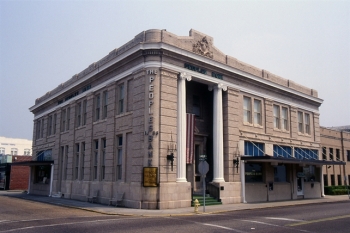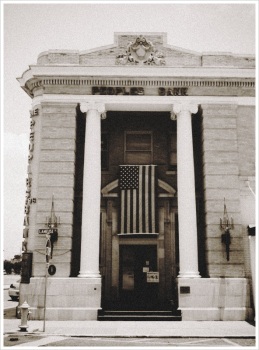This Unbuilt Mississippi post features what would have been the tallest structure in downtown Biloxi until the construction of the Santa Maria del Mar in the early 1970’s. I was able to find this nugget in a 1908 issue of The American Architect.
Biloxi. — It is expected that work will begin within from thirty to forty-five days on the Harrison County Bank Building, which is to be erected on the Lemon corner, at Howard Avenue and Lameuse Street, at a cost of $40,000. It will be five stories in height, built of brick. R.H. Hunt, of Chattanooga, is the architect. D. J. Gay, President of the Harrison County Bank, is the owner. Bids are soon to be asked for.
–The American Architect Vol. XCIV., No 1722. Page 16
The article makes the construction sound like an inevitability, but by the time the corner was documented in the June 1909 Sanborn fire insurance map, no building is indicated as being under construction. It is possible that the quotes might have come in quite higher than the $40,000.00 estimate, which would have been a little more than $1,000,000.00 in 2015. Possibly some “value engineering” led to the building that exists there today. By 1914, Harrison County Bank had built on the site, a two-story building that would have roughly cost half as much to construct. By 1924, Harrison County Bank was bought by People’s Bank, which still occupies the structure to this day.

Peoples Bank, 152 Lameuse St Biloxi Harrison County. MDAH, No Date from MDAH HRI db accessed 7/15/2015
If you are familiar with previous posts about Architect Hunt you will know he was no slouch, having designed at least 100 buildings in Mississippi, almost all of them major landmarks in their communities, all the while training some of the next generation of Mississippi’s significant architects. Is it possible that Hunt designed the two-story bank? Who knows, but if you’ve ever seen the structure in person you know if fits the bill of being a community landmark, worthy of a R.H. Hunt design.
Categories: Architectural Research, Banks, Biloxi, Historic Preservation


You know, the whole concept of “unbuilt” just triggers all kinds of thoughts, doesn’t it?
LikeLike
It makes you wonder about how bad a shape Harrison County Bank was in. It wasn’t until I studied the sanborn map that I really understood the original program for this building. The bank barely occupied 1/5 of the building. I’ve tried to indicate the area they occupied in the image below. But three other business were on the first floor and the entire second floor as rented out as well. All much scaled back from a 5 story building.
LikeLike
Wow! But then, how much space did a bank need in 1908?
LikeLike
That i am not sure of. If there is a collection of Hunts drawings I wonder if the plans for the building still exist
LikeLike
I came across an article that states that the first floor of the five story building would be used for the bank, two shops and a barber. The top floor would be for an Elks lodge, another floor would be for a Knights of Columbus hall. The remaining two floors would contain 15 to 20 offices. But the article goes on to state that neither the Elks or the KofC had been approached in any official capacity about locating their organizations in the building. If either of these organizations had never intended to locate in the building it would make sense why a two story structure ended up being built.
LikeLike
Evidently Franklin Associates inherited many of his drawings through successor firms…
http://www.franklinarch.com/practice
LikeLiked by 1 person
But as Malvaney and I discovered by visiting Franklin and Associates several years ago, the firm destroyed the drawings for Hunt’s Mississippi buildings. Flooding resulting in wet drawings and perhaps most importantly, the impossibility of saving Hunt’s very large collection of drawings when it became necessary to remove them from a Chattanooga building. The firm had a nice but small archives area for the drawings that were saved and those were mostly for Tennessee buildings.
LikeLike
Oh what terrible news. Thank you for filling us in on this loss.
LikeLike
LikeLike